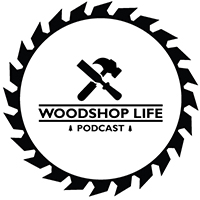Brians Questions:
Gentlemen,
Thank you so much for this podcast. I very much look forward to each episode. I primarily work with hand tools making traditional furniture. One of the few machines I own is a PowerMatic 15” bandsaw. Guy’s positive review of it sealed my decision and I’m very happy with it. Fantastic bandsaw. I mostly use it for long straight cuts and keep the Laguna 3/4” carbide tipped blade in it. On the occasions I need to make curve cuts I hate to change out blades. Call me lazy. I’d like to get another tool for this other than doing it by hand. It could be a smaller band saw with a thin blade, the DeWalt DW788 scroll saw, or something else. Mostly cuttin 4 quarter stock but on occasion eight quarter stock. What would you get and why? I also own a Makita corded jigsaw. Many thanks and keep up the great work.
Sincerely
Joe Leonetti.
Having two friends recently experience serious injuries while using their table saw, I am continuing to do more ripping using my bandsaw for safety sake. (I, like my two injured friends are in our 70’s- not as quick in our reactions, as good in our judgements or dexterous as when younger.) I’m fortunate to have two bandsaws, one of which I keep a 1/2” blade on for the purpose of resawing and ripping, so it works out quite well. The issue is the rough edge left by the bandsaw vs the smooth “gluable” edge that the table saw produces. What’s the best way to address this? I’ve heard mention of using a jointer after ripping – does this not introduce uncertainty as to the final width of the piece just ripped? For example, if I wanted a piece 10” wide and ripped it to 10 1/16”, I’d have to have my jointer set to remove exactly 1/16 which even if I accomplish that setting, may be hard to achieve and also get a perfect 90 degree edge. As an aside- I’m still considering selling my Powermatic and getting a Sawstop in the interest of increased safety. While some people might scoff at that idea, I don’t care-to each his own. Both of my two friends injuries were ugly, debilitating and expensive. Thanks for the best and most informative woodworking podcast! Tim Deal
Guys Questions:
Hello Huy and Guy, and welcome to the show Brian. My question today is about quoting pricing for inconvenience. What I mean by that is this: if a client comes to you with a request that you aren’t really excited about does that affect how much you quote? Do you ever give them a high quote in the holes that they say no, but high enough that if they still say yes, it offsets any frustration you expect to have while building?
Thanks, and I’m still waiting for Brian’s social media… and for Guy to say specificity again.
Joshua.
Huy’s Questions:
Great podcast guys. I Really appreciate how you guys answer questions based on your individual experiences. I like hearing 3 or 4 different ways to perform a task using a variety of tools. My question: my current home has 1/2” particle drawer boxes and I’m replacing them. What would you recommend for drawer box construction concerning material, thickness, drawer bottom thickness, and finish. Thanks.
-Eric Brown
Greetings Gentlemen,
Thank you for continuing your podcast into 2023. It’s very informative, but in a relaxed and casual format. Also; a welcome to Brian. Sean was a long time co-host and will be missed but Brian has slipped into his slot with ease and is doing great.
My question today is about planing. I’m making a 4×6 ft table top out of true 1-1/8 inch thick x 6 inch wide, rough cut white oak. When dressing down the wood, I plan on jointing one surface then planing the other surface parallel. Finished thickness I think will be between ¾ and 7/8. Here is the question. How important is it to take equal amounts off of each side? Can I just joint one surface and plane the opposite down to my finished thickness or do I have to try to take an equal amount off of both sides. If it matters, the lumber is kiln dried down to 7%.
Terry W.
